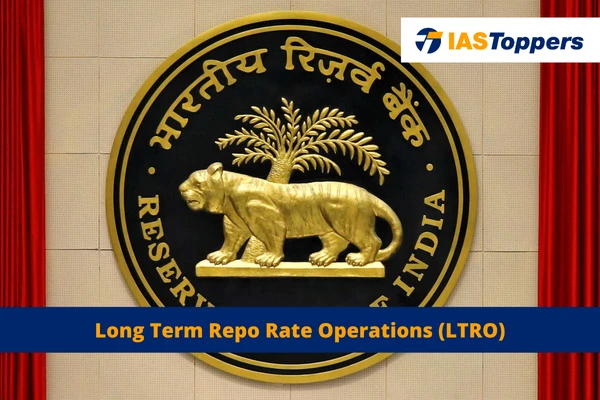Long Term Repo Rate Operations (LTRO) is a monetary policy tool used by the Reserve Bank of India (RBI) to provide long-term liquidity to banks at the prevailing repo rate. The operation is instrumental in ensuring banks’ access to funds for durations longer than the typical short-term windows of 1-28 days. In this article, you will know about meaning and definition of Long-Term Repo Rate Operations (LTRO), its significance, TLTRO etc. all of which are important for GS Paper-3 Economy subject of UPSC IAS Exam. To explore more interesting UPSC Economy topics like LTRO, check out other articles and IAS Notes of IASToppers.
Table of Content
- What are Long Term Repo Rate Operations (LTRO)?
- Significance of Long Term Repo Rate Operations
- What is Targeted Long Term Repo Operations (TLTROs)?
- What is objective ofTargeted Long-Term Repo Operations?
- Targeted Long Term Repo Operations 1.0 vs Targeted Long Term Repo Operations 2.0
- Conclusion
What is Long Term Repo Rate Operation (LTRO)?
- Launched in February 2020, LTRO are repo operations conducted by RBI for 1 and 3 years at the prevailing repo rate.
- It was introduced to provide liquidity at reasonable cost relative to market conditions, and to augment credit flows to productive sectors.
- LTRO provides banks with long-term liquidity, in contrast to RBI’s present windows of Liquidity Adjustment Facility (LAF) and Marginal Standing Facility (MSF), which provide funds for their short-term needs of 1-28 days.
- Funds through LTRO is provided at the repo rate but with higher interest rates.
- LTROs are conducted on E-KUBER platform.
- The e–Kuber is the Core Banking Solution of the RBI which enables each bank to connect their single current account across India.
- Minimum bid amount is 1 crore and no restriction on the maximum amount for individual bidder.
Significance of Long Term Repo Rate Operations
- Lowering funding expenses for banks: It enables the RBI to ensure that banks’ marginal cost of funds-based lending rates is lowered while policy rates are left unaltered.
- Better Transmission: LTRO enables better transmission of actions of RBI’s monetary policy.
- Ensuring long-lasting liquidity for banks: These measures are implemented to provide banks with access to sustained liquidity at a reasonable cost in comparison to current market conditions.
- Facilitating credit flow within the banking sector: By encouraging banks to smoothly and efficiently engage in maturity transformation, the LTRO aims to enhance credit flow throughout the banking sector.
- Stimulating investment: LTRO lead to a decrease in short-term interest rates, which in turn will promote investments in corporate bonds. LTRO stops the market’s short-term interest rates from diverging significantly from the repo rate, which serves as the policy rate.
- Expanding Monetary Policy Tools: LTRO showcases that the Reserve Bank of India (RBI) uses a variety of instruments, not just adjusting repo rates and executing open market operations, to accomplish its objectives.
What is Targeted Long Term Repo Operations (TLTROs)?
- They are conducted by the RBI to ensure adequate liquidity at the longer period for specific (targeted) sectors.
- Under TLTRO, banks borrow funds from RBI at repo rates, which they have to invest in specific sectors like corporate and Non-bank financial institution (NBFCs) through debt instruments (corporate bonds, commercial papers, and non-convertible debentures (NCDs)) to push the credit flow in the economy.
- There are no maturity restrictions on the securities that are acquired under TLTRO scheme.
- However, banks need to keep their Held to Maturity (HTM) specified security portfolio above or equal to the amount that has been availed under the TLTRO scheme.
- Held to maturity securities are securities that companies purchase and intend to hold until they mature.
- However, banks need to keep their Held to Maturity (HTM) specified security portfolio above or equal to the amount that has been availed under the TLTRO scheme.
What is objective ofTargeted Long Term Repo Operations?
- The COVID-19 pandemic caused challenges for corporations and non-banking financial companies (NBFCs) in securing funds due to massive sell-offs in domestic stock, bond, and foreign exchange markets.
- To address this issue, the Reserve Bank of India (RBI) introduced Targeted Long Term Repo Operations (TLTRO) as a means of supplying liquidity to the corporate bond market.
- Under TLTRO, RBI provided funds to banks at cheaper rate and for a higher tenure which they, in turn, can lend out to businesses in terms of investment-grade corporate bonds. This, in turn, encourages them to lend more and spur economic activity.
- The funds obtained through TLTRO can also be employed to give bank loans to struggling sectors and invest in higher-yielding assets to enhance profitability.
Targeted Long Term Repo Operations 1.0 vs Targeted Long Term Repo Operations 2.0
| Targeted Long Term Repo Operations 1.0 | Targeted Long Term Repo Operations 2.0 | |
| Source of fund | RBI auctioned funds to banks | Same as TLTRO 1.0 but focused on smaller NBFCs and MFIs who earlier missed out on getting any relief. |
| How much fund is auctioned | Total LTRO was set at Rs 1 lakh crores and completed in four traches (Rs 25000 crore each) | Varying Auction Amounts |
| Interest rate | Floating rate based upon the prevailing repo rate | Same as TLTRO 1.0 |
| Where the banks should invest? | In bonds and other securities issued by corporate | In Debt Instruments issued by non-banking financial institutions (NBFC) and Microfinance institutions (MFI). Small and mid-sized NBFCs and MFIs should receive at least 50% of these funds. |
Conclusion
Long Term Repo Rate Operations (LTRO) and Targeted Long Term Repo Operations (TLTROs) have emerged as crucial tools for the RBI to manage liquidity and promote credit flow in the economy. Going forward, the Indian government should continue to evaluate and refine these operations to ensure their effectiveness in addressing the evolving financial needs of India and promoting sustainable economic growth.
Ref:
FAQs(Frequently Asked Questions)
What is Long Term Repo Rate Operation?
Long Term Repo Operations (LTRO) are a liquidity management tool by the Reserve Bank of India (RBI) that offers banks funding for 1-3 years at the prevailing repo rate.
What is the significance and importance of Long Term Repo Rate Operations?
Long Term Repo Rate Operations is important for lowering funding costs for banks, ensuring lasting liquidity, enhancing credit flow, promoting investment, and improving monetary policy transmission.
What is the objective of Targeted Long Term Repo Operations?
Targeted Long Term Repo Operations aim to supply liquidity to the corporate bond market, especially during crisis situations, by allowing banks to lend more to businesses and spur economic activity.
How do Targeted Long Term Repo Operations 1.0 and Targeted Long Term Repo Operations 2.0 differ?
While Targeted Long Term Repo Operations 1.0 involved RBI auctioning funds to banks to invest in corporate bonds, Targeted Long Term Repo Operations 2.0 focused on providing relief to smaller non-banking financial institutions (NBFCs) and microfinance institutions (MFIs).



